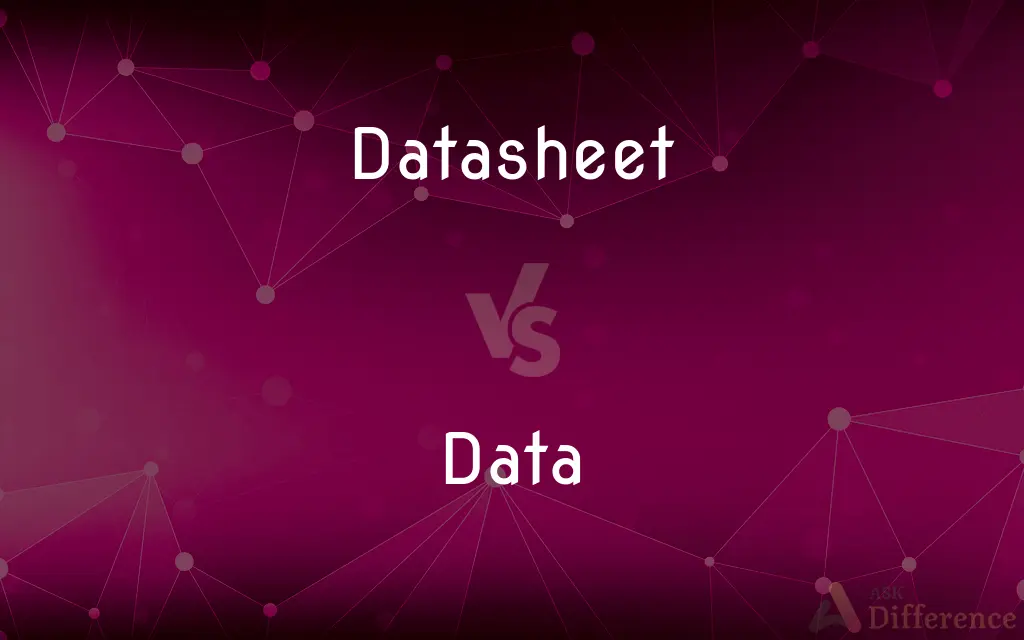Datasheet vs. Data — What's the Difference?
By Urooj Arif & Maham Liaqat — Updated on April 1, 2024
A datasheet is a document summarizing the performance and other technical characteristics of a product, while data refers to facts or information used for reasoning or calculation.

Difference Between Datasheet and Data
Table of Contents
ADVERTISEMENT
Key Differences
Datasheets provide comprehensive details about a product, component, or system, including specifications, features, applications, and performance metrics, serving as a crucial resource for understanding and evaluating technical products. Data, on the other hand, encompasses a broad range of factual information, quantitative or qualitative, collected through observation, measurement, research, or analysis, used to support decisions, theories, or calculations.
While a datasheet is structured and specifically tailored to present all relevant information about a particular product or component, data can be unstructured or structured, raw or analyzed, existing in various forms such as numbers, text, images, or recordings, and applicable across diverse contexts beyond just technical specifications.
The primary purpose of a datasheet is to inform potential users, engineers, or buyers about the critical aspects of a product to aid in selection, usage, or integration into larger systems. In contrast, data serves a foundational role in knowledge creation, problem-solving, and analysis in fields ranging from science and technology to business and social studies.
Datasheets are typically generated by manufacturers or developers to provide a clear and concise reference for their products, ensuring that all necessary technical information is readily available. Data, however, can be generated or collected by anyone researchers, businesses, individuals and is used to derive insights, make predictions, or inform strategies and decisions.
The value of a datasheet lies in its ability to succinctly communicate specific details about a product's capabilities and requirements, facilitating comparison and compatibility assessment with other components or systems. The value of data lies in its ability to be analyzed and interpreted to reveal patterns, trends, or insights, driving informed decision-making and innovation.
ADVERTISEMENT
Comparison Chart
Definition
A document summarizing the technical characteristics of a product.
Facts or information collected for analysis or decision-making.
Purpose
To inform about product specifications, features, and applications.
To support reasoning, analysis, or calculation across various fields.
Form
Structured document, typically specific to a product.
Can be unstructured or structured, existing in numerous formats.
Creation
Generated by manufacturers or developers to describe their product.
Collected or generated through observation, research, or measurement.
Value
Facilitates understanding, comparison, and usage of products.
Enables insight generation, problem-solving, and decision-making.
Compare with Definitions
Datasheet
Aids in product selection, usage, and integration into systems.
By reviewing the datasheet, the designer could ensure the component was suitable for the circuit.
Data
Can be raw, analyzed, visualized, or reported in various ways.
The data from the survey was compiled into an easy-to-read chart.
Datasheet
A technical document that provides detailed information about a product’s specifications.
The engineer consulted the microcontroller’s datasheet to understand its pin configuration.
Data
Quantitative or qualitative information collected for analysis.
The researcher gathered data on water quality across several lakes.
Datasheet
Primarily used by engineers, technicians, and product developers.
Technicians regularly refer to datasheets when troubleshooting hardware issues.
Data
Researchers, businesses, policymakers, and individuals.
Environmental scientists use data from satellite images to track deforestation rates.
Datasheet
Structured format, often with diagrams, tables, and technical details.
The datasheet included a detailed wiring diagram for proper installation.
Data
Used to inform decision-making, research, or theory development.
Business decisions were made based on customer feedback data.
Datasheet
Includes specifications, operating conditions, and application guidelines.
The datasheet for the LED light specifies its voltage requirements and luminosity.
Data
Can include numbers, text, observations, or images.
The study's data included both statistical analyses and photographic evidence.
Datasheet
A document summarizing the performance and other technical characteristics of a product.
Data
Data are units of information, often numeric, that are collected through observation. In a more technical sense, data are a set of values of qualitative or quantitative variables about one or more persons or objects, while a datum (singular of data) is a single value of a single variable.Although the terms "data" and "information" are often used interchangeably, these terms have distinct meanings.
Datasheet
A display of the records in a table, arranged in rows and columns.
Data
Plural of datum
Data
Information, especially in a scientific or computational context, or with the implication that it is organized.
The raw information was processed and placed into a database so the data could be accessed more quickly.
Data
(collectively) Recorded observations that are usually presented in a structured format.
Data
(computing) A representation of facts or ideas in a formalized manner capable of being communicated or manipulated by some process.
Data
Senseid|en|telephony}}(mobile telephony) {{ellipsis of mobile data: digital information transmitted using the cellular telephone network rather than Wi-Fi.
Run out of data
Data
See Datum.
Data
A collection of facts, observations, or other information related to a particular question or problem; as, the historical data show that the budget deficit is only a small factor in determining interest rates.
Data
Information, most commonly in the form of a series of binary digits, stored on a physical storage medium for manipulation by a computer program. It is contrasted with the program which is a series of instructions used by the central processing unit of a computer to manipulate the data. In some conputers data and execuatble programs are stored in separate locations.
Data
A collection of facts from which conclusions may be drawn;
Statistical data
Common Curiosities
What is the main difference between a datasheet and data?
A datasheet is a document summarizing a product's technical characteristics, while data refers to collected facts or information used for analysis or decision-making.
Who uses datasheets?
Datasheets are primarily used by engineers, technicians, product developers, and buyers to understand and evaluate products.
Can data be part of a datasheet?
Yes, data regarding a product's performance, specifications, and test results can be included within a datasheet.
How do businesses use data?
Businesses analyze data to understand market trends, customer preferences, and to make strategic decisions.
Can a datasheet influence product selection?
Absolutely, datasheets provide essential information that helps users compare and select products based on their technical requirements and compatibility.
Why is data important?
Data is crucial for informed decision-making, research, and deriving insights across various fields, including science, business, and technology.
How are datasheets created?
Manufacturers or developers create datasheets to provide detailed information about their products, ensuring users have access to necessary technical details.
What formats can data take?
Data can be numerical, textual, visual (like images or videos), or observational, and it can be presented raw or after analysis.
Is a datasheet always technical?
Yes, datasheets are technical documents that focus on the specifications, features, and applications of products.
What role does data play in scientific research?
Data is foundational in scientific research, used to test hypotheses, explore phenomena, and contribute to scientific knowledge.
Share Your Discovery

Previous Comparison
Gully vs. Sump
Next Comparison
Oracle vs. SoothsayerAuthor Spotlight
Written by
Urooj ArifUrooj is a skilled content writer at Ask Difference, known for her exceptional ability to simplify complex topics into engaging and informative content. With a passion for research and a flair for clear, concise writing, she consistently delivers articles that resonate with our diverse audience.
Co-written by
Maham Liaqat













































